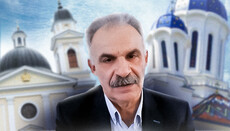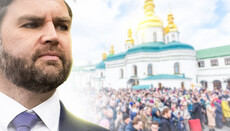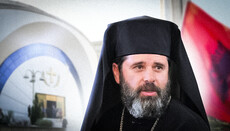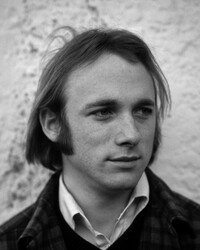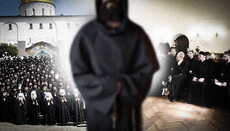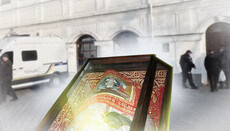Day of Rus Baptism: Great Cross Procession and dissenters without resource

Why the UOC procession on the eve of the Day of Rus Baptism was called Great, while two processions of schismatics were scanty and not backed by administrative resource.
On July 27 and 28, 2019, Kiev hosted the celebration of the Day of Christianization of Rus and commemoration of the Holy Prince Vladimir.
The celebrations of this year were so dramatically different from previous years. They differed at once in so many ways – by the composition of the participants, their number, attitude to them from the authorities, the media and Ukrainian society.
Let's take a closer look at what has changed in the current 2019 year.
300 thousand believers join the Great Cross Procession
Amazingly, at the Cross Procession of the Ukrainian Orthodox Church in 2019 there were even more believers than in the past.
Last year there were a lot of participants, but they had a completely different mood – which can be called pre-storm. We perfectly remember the processions that took place in the hardest time, when the Church was under great pressure from the authorities, schismatics and the media, when the hierarchy and believers were simply defamed and harassed, when Phanar and Poroshenko had already launched the flywheel of legalizing schismatics, and believers could not believe that the Mother Church is capable of such a betrayal.
Then people prayed for the preservation of their Church and their prayers were answered.
This year there was a completely different mood. The believers radiated light, joy, and inspiration.
Metropolitan Luke, a ruling bishop of Zaporozhye Eparchy of the UOC: “People have revealed some kind of special joy. If earlier, for the last 5 years, believers were concerned about what would happen to them and what would happen next year, this year people would come up and say: Vladyka, don’t forget about us next year, we will definitely go. So, they are looking forward to the future.”
Metropolitan Iriney, a ruling bishop of Dnepropetrovsk Eparchy of the UOC: “I had a talk with bishops from many eparchies – a lot of believers came. All in all, more than 300 thousand are reported. This is the grace of God; people felt genuine freedom, which is most valued."
Metropolitan Joasaph, a ruling bishop of Kirovograd Eparchy of the UOC: “Last year, our Church experienced real persecutions and they really consolidated people. Yesterday (July 27 – Ed.) there was a sea of people, in concert, in a unified voice and heart, glorifying God and testifying to their Orthodox paternal faith."
Despite the fraud of the old regime with the Tomos, despite large-scale seizures of temples and actual persecution, the Church has withstood and strengthened. People prayed this year. But these were, rather, prayers of gratitude.
With old power gone – gone are the problems around organization of the UOC Cross Procession
All previous years, real hysteria was fueled around the religious procession of the Ukrainian Orthodox Church – the participants were called terrorists and separatists in robes covering weapons. Demands were voiced to arrest the believers and to ban their procession. Activists did not let out buses with believers from the eparchies to Kiev, the police found bombs along the cross procession route, and law enforcement officers zealously warned of impending provocations, naturally from the Russian special services.
Vadim Skibitsky, representative of the Main Intelligence Unit of the Ministry of Defense of Ukraine (speech during the All-Ukrainian Cross Procession of the UOC in 2016): "Provocative actions against the UOC will be organized and carried out by Russian special services with the involvement of criminal groups."
In 2016, the deputies of Boryspil City Council generally banned UOC believers from entering the city. We still remember the police thoroughly searching the believers and their belongings.
The real hate hysteria towards the cross walkers was swelling in the media, who were insulted by journalists and even ministers.
Roman Chaika, a journalist of Channel 5 (live broadcast in 2016): “Such young bull-like people (in the procession of the UOC – Ed.) look very solid against the background of old women with the Orthodoxy-hit brain.”
Yevgeny Nishchuk, a Minister of Culture of Ukraine (live broadcast in 2016): “There (in the procession of the UOC – Ed.) there are just people with absolutely ... Well, they are inadequate people.”
Oleg Bondarenko, an activist (from his address to the believers of the UOC in 2016): “You will not leave Kiev alive, you,who pray to an alien God, the Moscow God.”
In 2019, despite the record number of participants, the procession was almost imperceptible, in fact, it came off as it was supposed to in a state whose Constitution says that the Church is separated from it.
There was almost neutral information in the media about the cross procession of the UOC, the police did not establish any metal detectors frames. But the most surprising thing – there were no provocations.
Lawyer Andrei Portnov so bluntly wrote: “The Cross Procession in Kiev. No news about Russian spies, provocations of special services and Russian Intelligence Service officers disguised in robes. They’ve run out of the feed, which the country was stuffed with during five years by Poroshenko, Parubiy and others. A short conclusion is that with their departure from power, religious hostility has come to an end.”
No Poroshenko – no people in a schismatic cross procession
It is no secret that the Kiev Patriarchate has always tried to present itself as the most numerous denomination in Ukraine. For this end, a variety of polls was made, it was tirelessly highlighted in the media and accentuated by dissenters themselves.
Filaret, the head of the UOC-KP (from the briefing in 2017): “Our cross procession is bigger – more clergy and more people, much more. In a similar way the Kiev Patriarchate today is the largest Church in Ukraine.”
Eustraty Zoria, OCU spokesman (from the live broadcast in 2017, when he held office of spokesman of the UOC-KP): “The Kiev Patriarchate has 2–2.5 times more supporters than the Moscow Patriarchate (UOC – Ed.). “The number of those who belong to the Kiev Patriarchate is on the rise year by year, while the number of those who affiliate with the Moscow Patriarchate (UOC – Ed.) is constantly decreasing.”
But two consecutive religious processions of the UOC on July 27 and the UOC-KP on July 28 have always vividly shown that all this discourse is just a lip service.
After Euromaidan, the so-called patriotic denominations of the Kiev Patriarchate and the UAOC entered into an alliance with the new authorities and became one of the mouthpieces of their policy.
In response, the authorities fully supported these structures and began to promote their interests. Not for free, of course.
It is known that one of the main pillars of Poroshenko’s presidential campaign was the Tomos for OCU. All effort of state power was hurled to promote this project. In particular, this included the organization of the procession of the Kiev Patriarchate in 2018 – mass delivery of public employees from all over the country, the distribution of national flags of Ukraine and banners, broadcasting through all central channels.
But all these efforts did not help either Poroshenko or the OCU.
Petro Poroshenko had a crushing defeat in the presidential and then parliamentary elections. Moreover, before the elections to the Rada, Poroshenko was engaged in luring Greek Catholics and urging everyone to pray with them.
Petro Poroshenko, MP of Ukraine: “I am here today, together with hundreds of thousands of people, therefore we pray together. Take part in the shared prayer and it will forever remain in your heart. Sorry, but you won’t feel it on television, it’s incredible. Whoever you are – come to Zarvanitsa (center of large-scale pilgrimage of the UGCC – Ed.) to the service.”
Although Poroshenko came to take part in the OCU’s procession this year, his presence didn’t help this structure. Indeed, he is no longer the president, but an ordinary deputy, whose party received about 8 percent of the vote. He no longer has the same fantastic administrative resource, respectively – the OCU went back to square one.
We can compare their three processions.
In 2017, where the column of the UOC-KP looked more than modest. In 2018, where thanks to Poroshenko there was a truly imperial scope. And in 2019, where there were as many people as in 2017 and previous years.
We can see the entire column of the OCU on the frames of the copter. It is difficult to say how many people were there, but even the police still having the personnel from the time of Poroshenko counted that the participants in the “Ukrainian religious procession” of the OCU were four times as few as in the past – 15 thousand against 60.
A break in breakaway groups
The main slogan of Poroshenko, Phanar and schismatics during the formation of the OCU was the one about the supposed unification of ALL of Ukrainian Orthodoxy.
Of course, it was an outright lie. And it became even more pronounced after the OCU had split in itself.
Recall that in June 2019, Filaret said that Tomos is actually slavery; the OCU is dependent on Phanar thus, a new split was caused. And since he no longer has such resources as in previous years, on the Day of the Baptism of Rus, Filaret held his separate small procession around St. Vladimir Cathedral.
***
But no matter how many schisms the schismatics may have, the believers of the Ukrainian Orthodox Church do not pay attention to this.
The procession on the Day of the Baptism of Rus became so vast that in 2019 it was already called Great. And it is really so.
There aren’t Orthodox processions of this magnitude, perhaps, anywhere, in any Local Church. But the main thing is not even the number of walkers.
The Great Cross Procession is a place where Orthodox Christians can feel their unity and their power. After all, our Church consists of thousands of communities which nearly always pray separately in their temples.
And now at one place and at one time, we can see how many of us are bright, pure, faithful to our faith, faithful to the Church, faithful to Christ.
In all states and at all times they have always tried to build an ideal society, but each time it was unsuccessful. It failed because in this society there was no place for Christ.
Each of us, Orthodox, seeks to live in such a way as to enter the Kingdom of Heaven. It is there, in Heavenly Jerusalem, where an ideal society exists being unattainable on earth.
And here, at the Great Cross Procession, we can already witness a lot of its future residents.
